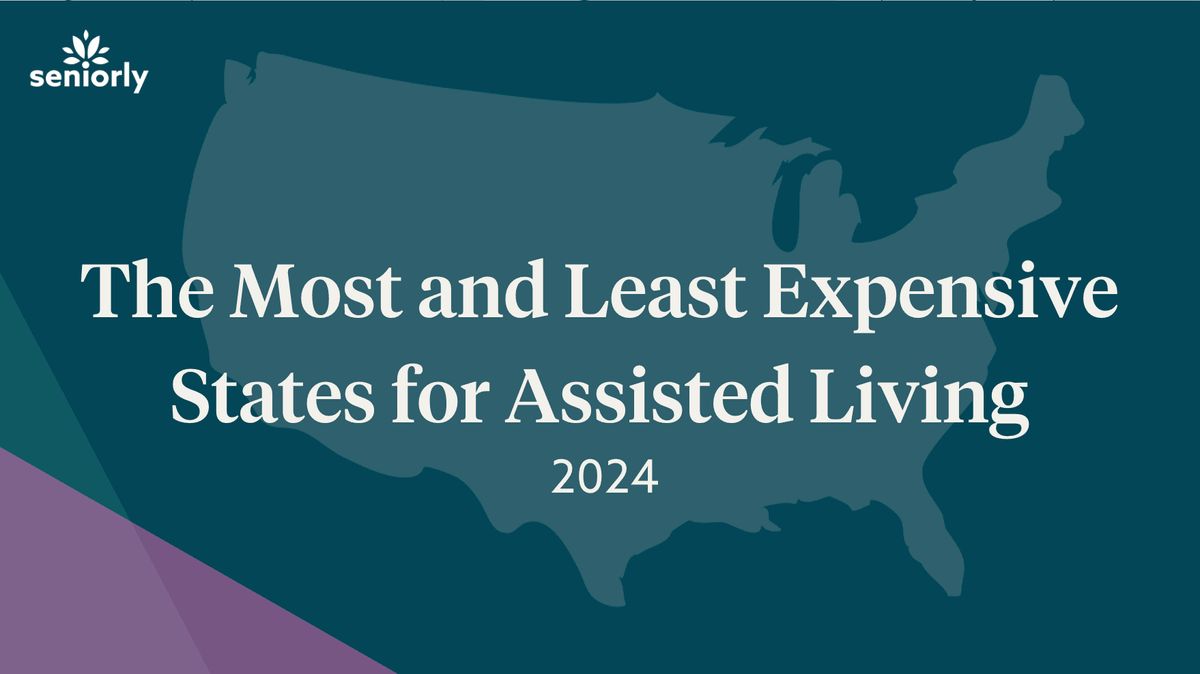The Most and Least Expensive States for Assisted Living in 2024
Curious about how your state ranks for assisted living affordability? Seniorly's got the latest data on assisted living costs, and where they've increased the most in recent years.

Nearly 58 million Americans are now aged 65 or older – a whopping 17.3% of the population – and demand for senior housing is at a record-high.
Senior housing occupancy reached 84.4% in late 2023, and while that level is just below the pre-pandemic rate of 87.1%, it rose for the ninth quarter in a row, according to the National Investment Center for Seniors Housing & Care. The steady increase means that demand is now outpacing supply – and that rent and other costs are also on the rise for assisted living communities.

Assisted living communities are residential homes for seniors that offer extra help with day-to-day tasks like meals, transportation, laundry and medication management, but stop short of providing medical care. Additionally, these facilities offer a community of people in a similar life stage that can provide friendship and companionship, a huge benefit for aging Americans.
Keep in mind that room and board charges in assisted living communities are typically not covered by Medicaid, the federal program for low-income Americans. Medicaid can, in some cases, cover specific costs for medical care in nursing homes or assisted living settings. As a result, people who live in assisted living communities typically have to pay for the bulk of fees using their own resources, such as savings, a long-term care insurance policy or even selling a home.
But how much do assisted living communities actually cost, and how do those prices stack up against other options, such as in-home care? Seniorly, the leading marketplace for senior living, analyzed the average pricing of these settings and which states have the most and least expensive assisted living communities.
Here’s what we found:
- New Hampshire is the most expensive state. A spot in an assisted living community costs $8,248 per month on average, which is nearly double the national average of $4,401. Plus, it's only one of 6 states where assisted living costs more per month on average than in-home care.
- Assisted living is getting more expensive. Between 2021 and 2023, average costs rose in 30 states, with the biggest increases seen in Wyoming (53%), West Virginia (46%) and New Hampshire (46%).
- In-home care is more affordable than assisted living. Median costs for home health aides are cheaper than assisted living communities in all but six states. The biggest price differences are New Hampshire, where assisted living costs $1,674 more per month than in-home care, and on the other end of the spectrum, Minnesota, where in-home care costs $3,861 more than assisted living, on average.
Most and least expensive states
The average monthly rent for assisted living communities ranges from $2,946 in Louisiana to $8,248 in New Hampshire. Average costs are above $5,000 per month in 10 states, mostly concentrated in New England and the Mid-Atlantic. Meanwhile the most affordable states are spread across the U.S., such as Indiana ($3,695), Iowa ($3,420) and South Dakota ($3,378).

Seniorly price estimates factor in the distribution of community type and size, so states that have a higher concentration of large or higher-end assisted living communities are likely to have a higher average cost.
Assisted living is getting pricier
Across the U.S., average assisted living costs were $4,401 per month in 2023 – an 8% increase from $4,057 just two years earlier. Between 2021 and 2023, assisted living costs rose in 30 states, fell in 15 states and remained relatively flat in six states, meaning average monthly rent rose or fell by less than $90 per month.
To make matters worse inflation has been above the Federal Reserve’s 2% target since March 2021. According to the Bureau of Labor Statistics Consumer Price Index Calculator, the purchasing power of $4,401 – one month average cost of assisted living – would have afforded seniors just $3,796 back in March 2021, when comparing against the November 2023 CPI, the most recent data available at the time of this study. Overall prices for senior living are rising faster than inflation, according to the New York Times, meaning it’s more important than ever find the best care at an affordable rate.
Wyoming saw the biggest increase, with costs jumping from $3,845 to $5,894 – a 53% uptick – and seven other states saw increases of 25% or more. On the other hand, costs fell by more than 10% in nine states. Washington saw the biggest decline (16%), with costs falling from $4,995 to $4,176. Notably, costs fell by $835 in New Jersey, which was the most expensive state for assisted living in 2021. Even so, New Jersey still ranked in the top 10 most expensive states this year, with monthly costs at $5,058.

It takes 17.2 years of savings to afford one year in assisted living
To highlight just how much of a financial obligation assisted living can be, we calculated just how long the typical American needs to work in order to afford this type of care. We used the U.S. Census Bureau’s 2022 median annual household income for each state and assumed savings of 4.1% of the median earnings, which was the national average in November 2023, down from 7.5% in September 2021, according to the Bureau of Economic Analysis.
Using today's earnings and savings rates, it would take the average American 17.2 years to save for a year of assisted living.
Given this metric takes into account the prevailing wage rates in each area, it’s a metric of the affordability of assisted living in a state based on how much money its residents earn. New Hampshire again ranks first, with a median household income of $89,992, suggesting $3,689.67 in annual savings. That means it would take 26.8 years of savings to cover a single year of assisted living costs ($98,976). West Virginia, Mississippi, Wyoming and Delaware round out the top five.
Meanwhile, Maryland scored at the other end of the spectrum, with people needing to save an average of 11.7 years to cover assisted living costs for a year. Marylanders’ median household income is $94,991, translating to $3,894.63 in annual savings, which is just barely enough to cover a month’s stay in an assisted living community. The state is followed by Utah, Minnesota, Georgia, and Washington.
The chart below ranks each state based on the number of years people need to work in order to afford just one year of assisted living.

How in-home care stacks up
The cost of in-home care for seniors is typically also expensive, though it may be more or less affordable than assisted living depending on the state and your family’s expectations. According to Genworth Financial, which projected median costs for 2023, Americans can expect to pay $5,462 per month for a home health aide.
There’s wide variation between the states, though. In Minnesota, the most expensive state for home health aides, their median monthly cost is $7,333, compared to the $3,472 monthly bill for assisted living communities. In West Virginia, the least expensive state for home health aides, they cost $3,793 per month compared with the $4,846 average rent for assisted living.
Notably, however, home health aides cost $6,574 per month in New Hampshire, while a spot in assisted living is $8,248. That means it’s important for families to carefully weigh their options before making decisions about their loved ones’ futures.

Conclusion
For many older Americans, assisted living is the next phase of their residential life, serving as a place to make new friends and have lots of life’s little inconveniences handled by others. While this form of living can be extremely rewarding, it comes at a cost. Overall, though, choosing the right care for older family members involves more than just the price tag – it's about finding the right balance between financial practicality and genuine well-being. This kind of support ensures that our loved ones not only get the care they need, but also maintain their comfort and dignity as they age.
Methodology
The assisted living cost averages and rankings were derived from Seniorly2023 move-in data from across the company’s network of 60,000 senior living communities. As well as the company’s proprietary Pricing Estimator algorithm, similar to a Zestimate. You can find out more about Seniorly’s pricing estimates here.
To determine which states saw the largest increase in cost over time, we compared Seniorly’s 2023 data against 2021. .
To calculate how long it would take the average American to save for one year of assisted living, we divided the annualized cost of assisted living by families’ yearly savings. We used the national average savings rate of 4.1% from November 2023 from the Bureau of Economic Analysis and the median household income in each state from the U.S. Census Bureau.
The median cost of in-home care was derived from analyzing 2023 projections from Genworth’s Cost of Care survey as the official numbers from last year have not yet been released.
Arthur Bretschneider is CEO and Co-Founder of Seniorly. As a third generation leader in the senior living industry, Arthur brings both deep compassion and a wealth of practical experience to his work at Seniorly. Arthur holds an MBA from Haas School of Business and has been featured in the New York Times and Forbes Magazine as a thought leader in the senior living space. Arthur is a passionate and vocal advocate for improving the lives of older adults through community, and believes strongly that structured senior living environments can positively impact the aging experience.
To learn more about Seniorly's editorial guidelines, click here.
Sign up for our Healthy Aging Handbook
Seniorly’s Senior Living experts created a comprehensive handbook to help people age happily while ensuring they love where they live. Enter your email address below to receive your copy and learn more about Healthy Aging and Senior Living.*
*By submitting your email address above, you consent to receive occasional email communications from Seniorly, including educational content and tips, newsletters, and other relevant updates and offerings. You can unsubscribe at any time and we will never sell or distribute your email address to a third party. You can view our Privacy Policy here.
